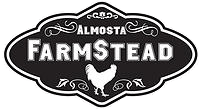





Almosta Farmstead
Peacocks
We adore peacocks...BUT...Are you ready for peacocks?
Peafowl are beautiful majestic looking birds. They are great fliers and will alert you of intruders.
Shopping List
Brooder Supplies: Waterer, feeder, heat lamp reflector, heat bulb, pine shavings, paper towels, electrolytes and vitamins, thermometer, gro-gel, draft-free enclosure, coop or other safe housing, gamebird feed, and grit. We offer the chick starter kit which includes everything you need to get started.
Suggested Reading
-
Let’s Get Started Raising Peafowl
-
Peacocks Past and Present
At the Post Office: Promptly pick up your package and get peachicks into the prepared brooder or release adult peafowl into a flight pen. If you ordered males with a tail, you will need to remove the tape, which is overlapped in about four places. Since the birds are shipped in a 3-foot box, their tales need to be taped to prevent them from becoming injured.
Live Guarantee: Look for the guarantee that properly cared for birds will be alive and well for 48 hours after they arrive at your post office. Look at the full policy and claim form when ordering peachicks online.
Brooder Requirements: One square foot per chick is recommended to start. The brooder must be sterile and draft-free and needs to be big enough so that the birds can move away from the heat source if needed. Peachicks are good flyers even after just a few weeks, so be sure to have a secure cover available for your brooder. Peachicks are fragile; proper care, temperature, and a draft free environment is crucial for their survival.
Temperature: A thermometer is a baby peachick’s best friend. Start your chicks off at 99 degrees for the first three hours. Then, keep them at 95 degrees for the first week. Reduce the temperature by 5 degrees each week until they are fully feathered out, typically at 6 weeks and 70 degrees. Peachicks are very sensitive, so be sure the temperature is always stable.
Water: When placing your chicks in the brooder, immediately dip their beaks in water to teach them how to drink. Peafowl need to have access to clean drinking water at all times. Use a 1 quart chick waterer. Clean marbles in the dish will help prevent drowning. Warm water for the first few hours may be beneficial. Include vitamin or electrolyte powder in the water for an extra boost after the third day for up to 5 days at a time and during times of stress.
Feed: Food should be available at all times. Peachicks may have a difficult time eating, so you can start them off with cooked eggs (mashed up) or cottage cheese for the first few days, and then start them on a gamebird feed or turkey starter of 28-30% protein for 6 weeks. Thereafter, they will do just fine on a gamebird grower/maintenance feed. If dirt or pebbles are not accessible, you should provide grit for proper digestion. Peafowl also enjoy greens, shelled or cracked corn, oats, sunflower seeds, insects and other forage. White millet can be used as a training aid or treat.
Litter: The best option for bedding material is 2 inches of large size kiln dried pine shavings. Use paper towels above the shavings for the first few days. Do not use sawdust or cedar shavings. The bedding must be kept clean and dry for optimum health.
Coop and Run Considerations: A flight pen for a trio of breeding peafowl should be twenty feet long with a shelter at the end to escape extreme weather and to nest or roost. The shelter should be at least six feet tall and wide enough for the male to spread his tail feathers. Peafowl are great fliers and can become semi-wild if left to free range, so you will want to keep the flight pen covered. Peafowl are prone to frostbite so provide them with a roost wide enough for them to keep their feet flat, such as a 2x4 board. 1 peacock can fertilize as many as 5 peahens. Java Green Peafowl cannot be allowed to freeze. They must be confined to the warmer states or have a heated aviary for the winter in other climates.
Free Ranging: Once you put your peafowl in an outside run at 6-8 weeks of age, we recommend keeping them penned up for an additional 4 months if you intend to free range them to establish a home base. Peafowl love to free-range and will roost wherever is most comfortable for them. If you purchase adult peafowl, you should also keep them penned up for at least 4 months before letting them free range so they learn to know where their new home is.
Keeping peafowl with other birds: Peafowl can be kept with other pheasants and fowl, but precautions must be taken. Regular worming is a must. We do not recommend keeping turkeys and peafowl together.
Worms: Peafowl are susceptible to diseases caused by internal parasites. The best way to ensure the health of your peafowl is to worm them at least twice a year. We carry the Wazine Dewormer, but other brands and types can be just as effective.
Predators: Peafowl are great fliers. They will roost in trees, in your barn, or even on top of your house. They may be susceptible to predators, especially if roosting in trees at night.
Safe Handling of Poultry: After handling poultry, wash your hands with soap and warm water. Do not let young children, elderly persons, or people with weak immune systems handle or touch live poultry. Do not snuggle or kiss your birds. You can get salmonella from touching live fowl. Your birds can carry salmonella and still appear healthy and clean. Regularly clean and sanitize your poultry equipment.
